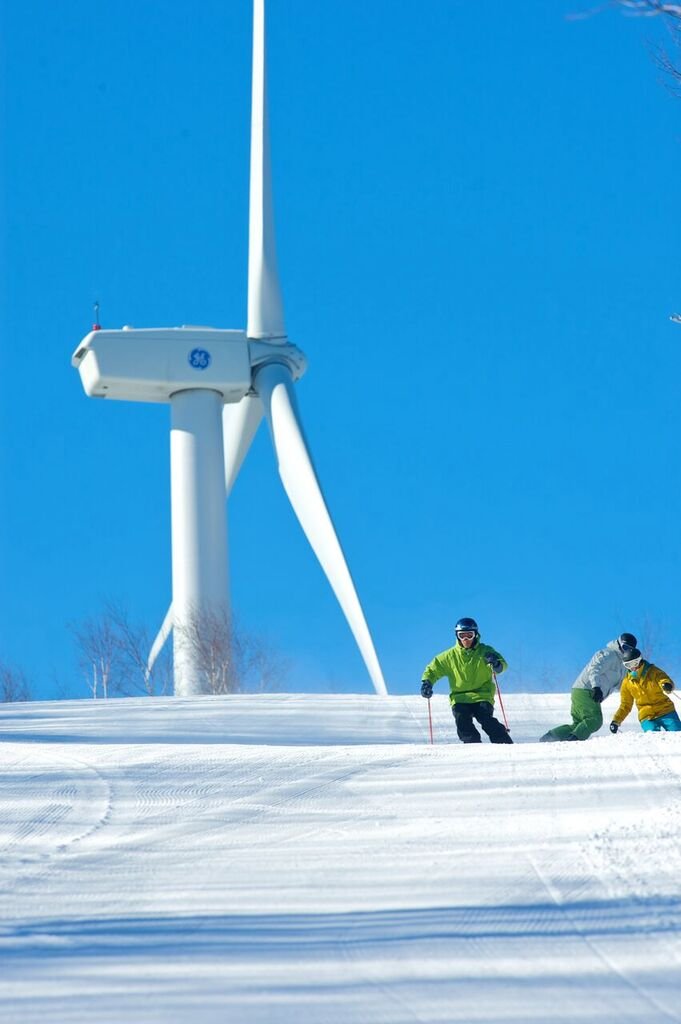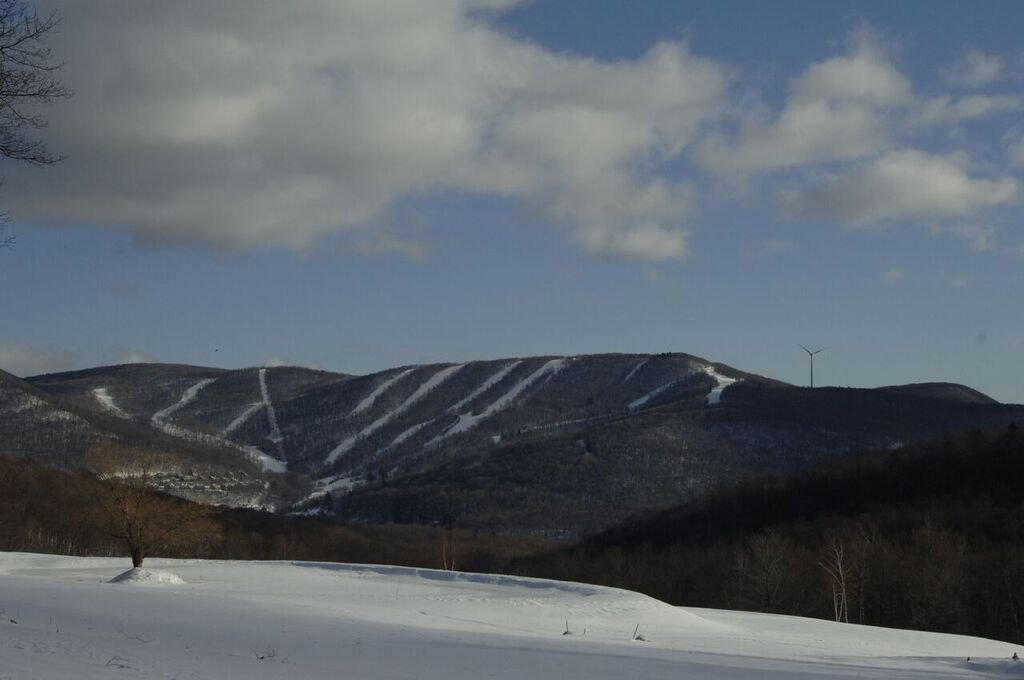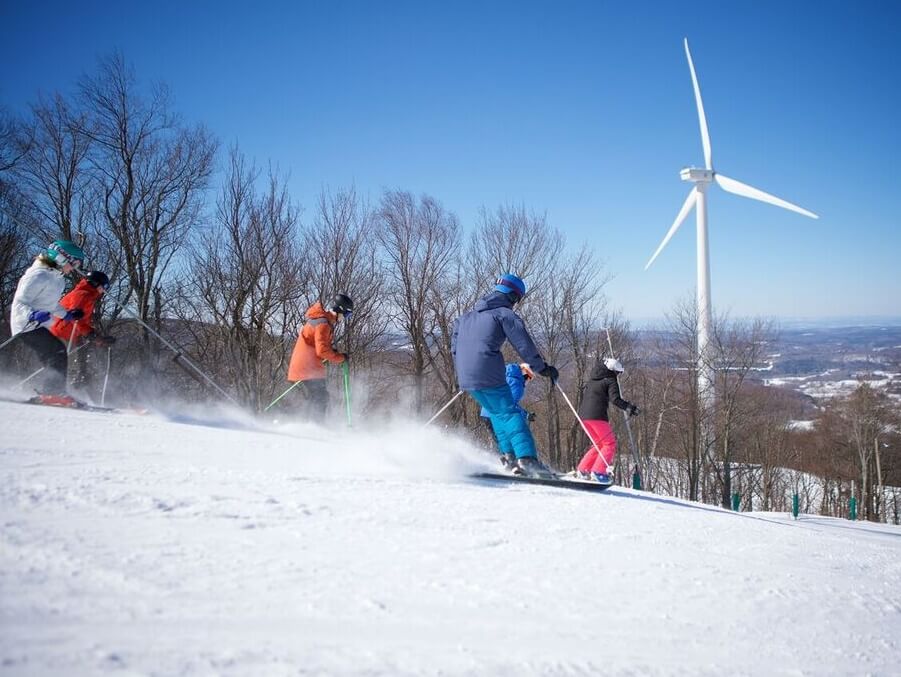On the 10th birthday of its 1.5 MW wind turbine, Jiminy Peak Mountain Resort in Massachusetts is highlighting what wind power has brought to the table for one of the few resorts in the U.S. powered 100% by renewable energy.
In 2007, when Jiminy Peak installed a $4 million wind turbine on the western flank of its mountain, many thought the 70-year-old resort was taking a huge financial risk, Jiminy Peak explains in a press release. This month, 10 years after the switch was thrown, Brian Fairbank, chairman of The Fairbank Group – which runs the resort – is looking back at a risk worth taking.
According to the resort, the 253-foot turbine paid for itself in seven years, and today, along with a 12-acre, 2.3 MW solar field and 75 kWh cogeneration unit at the slope-side Country Inn at Jiminy Peak, the resort is powered completely by clean energy.
When asked whether a second turbine is planned, Fairbank explains they already have all the electricity they need.
“We’re now focusing on drastically reducing our carbon footprint and greenhouse-gas emissions,” he says. “Conservation is the most cost-effective form of energy use reduction, cost control and containment.”
The resort says the turbine, when installed, was met with “great fanfare” and has become a symbol of the resort. Although its rotor bearings were replaced about 45 days into the turbine’s service life, the machine has run without major issues, says Jiminy Peak.
Moreover, the “Zephyr,” as it’s nicknamed, is the first megawatt-size turbine at a ski resort, and it remains the largest, claims Jiminy Peak, which also calls the turbine a “social media star.” In addition, employees wear turbine pins, and school groups often visit to tour the site.
“It has been an exceptional, dependable power producer for us,” says Jiminy’s Jim Van Dyke, vice president of environmental sustainability and a 43-year employee of the resort. “The turbine handles 33 percent of our energy needs on an annual basis – up to 66 percent in the winter when the winds blow  strongest.
strongest.
“As far as electricity is concerned, we’re already at 100 percent renewable power. We’re good. Excess power not needed by the resort goes out on the national grid, for which the resort receives credit to use when the turbine is working at less than full capacity or when the resort’s need exceeds the turbine’s capacity,” Van Dyke adds.
“Our focus now is upon reducing our carbon footprint. We’re still burning gasoline and diesel to run snowcats, still using propane to heat, and on busy weekends, 1,500 cars are in the parking lots, most with internal combustion engines.”
To that end, he points to a number of steps already taken to further reduce the resort’s impact on the planet. These include as follows:
- Installing a 2.3 MW community solar project with Massachusetts-based project developer and owner Nexamp Inc. The solar field, located near the base of the mountain, significantly expands Jiminy Peak’s renewable energy commitment while extending the environmental and cost-saving benefits of solar energy to the community.
- Replacing the entire 450-gun snowmaking arsenal with energy-efficient Snowgun Technologies “Sledgehammer” snowguns. The new guns convert more water with less air and at warmer temperatures than traditional snowguns. This means the resort runs air compressors for fewer hours, consuming less electricity while producing 100% more snow (assuming Mother Nature cooperates).
- Equipping two PistenBully groomers with SNOWSat digital mapping and GPS to tell drivers exactly how much snow is beneath their treads, blades and rollers. The maps are based on aerial photography captured during summer and are accurate to within two inches.
“Rather than eyeball it, the SNOWSat technology allows us to more precisely gauge depth and place more snow where the cover is thin, and less where the cover is already sufficient for skiing or riding. This means fewer passes by groomers,” Van Dyke explains.
Jiminy Peak is also purchasing the new energy-efficient Pisten Bully 600 E+ snowcat, one of three in use in the northeast, according to the resort. Built by German company Kassbohrer, Pisten Bully’s “Green Machine” 600E+ is the world’s first groomer with a diesel-electric drive, Jiminy Peak claims. It uses a diesel engine to drive two electric generators, which power electric motors that turn the tracks and the snow tiller.
According to Jiminy Peak, it reduces the emission of nitrogen oxides and carbon dioxides by 20%, produces 99% fewer sooty particles and registers a 20% fuel-savings over the standard 600 model.
In addition, the resort has installed four electric vehicle charging stations and switched to LED lights. Further, by using propane for both hot water and electricity, the Country Inn’s 75 kWh cogeneration unit eliminated one propane burner. Lastly, excess heat from two snowmaking compressors are used to warm three Village Center buildings, a total of 34,000 square feet, thus reducing propane and electricity consumption.
“We’re getting down to the granular level, including waterless urinals in all base lodges. Each one saves 40,000 gallons per year,” Van Dyke adds. “Conservation makes perfect business sense today, just as the turbine did 10 years ago.”





